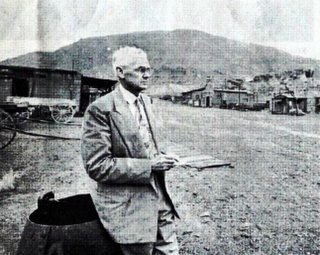Walter Knott

Walter Knott, farmer and amusement entrepreneur, was born on this day in 1889 in San Bernardino, California.
The story of Walter and Cordelia Knott's creation of Knott's Berry Farm, one of southern California's premier amusement parks and tourist attractions, stands in stark contrast to the planned vision of nearby Disneyland by Walt Disney.
After unrewarding years homesteading and working gold mines in the Mojave Desert and sharecropping around San Luis Obispo, California, the Knotts and their children settled onto 20 acres of rented land along Highway 39 in Buena Park, California. Knott planted berries and built a modest trade selling them throughout the 1920s. In 1932, Walter Knott began to grow a new hybrid berry, a cross between the red raspberry, the blackberry and the loganberry which he named the "boysenberry" after his friend, Anaheim parks superintendent Rudolph Boysen, who came up with the idea but could never make it work.
As times got rough during the Depression, Cordelia reluctantly began to serve 65¢ chicken dinners on her best china to passing motorists as a supplement to their income. With Cordelia's dinners and boysenberry pies as the star attractions, "Knott's Berry Place" became a popular roadside attraction, although even as Cordelia served 1,774 dinners on Thanksgiving Day, 1937, she steadfastly refused to admit that she was in the restaurant business.
The restaurant became so popular that their daughter Virginia added a gift shop in 1939, and in 1940 Walter Knott moved in some old buildings from Prescott, Arizona and began putting on an "Old West Ghost Town" cyclorama to entertain guests while they waited to be seated for dinner. By that time the farm had grown to 100 acres, all owned by the Knotts. Ploughing all his net income back into the business, by the 1970s "Knott's Berry Farm" became a full-fledged amusement park, with 4 theme sectors (Ghost Town; Fiesta Village, an homage to Spanish California; the Roaring 20s area; and an exact replica of Philadelphia's Independence Hall) as well as thrill rides (including the world's first corkscrew roller coaster).
In addition to its apparent lack of forecasted development, Knott's Berry Farm has always differed from its nearby rival Disneyland in its texture: unlike Disneyland, which designs its pathways in an effort to steer guests clear of tactile experiences with its buildings and trees, Knott's Berry Farm's more casual approach to foot traffic hides little of its rough-hewn and farm-like construction, giving it a kind of charm lacking in the highly artificial environment of Disneyland. If anything the park seems to have been guided by Knott's own perpetually folksy persona; even by the late 1950s, when the park was already a million dollar operation, Knott appeared on Groucho Marx's You Bet Your Life and simply described himself as a "farmer."
Sixteen years after Walter's death (on December 3, 1981 in Buena Park, California), the Knott family sold the park to Cedar Fair for $247 million in 1997, thereby jeopardizing the park's texture for posterity.
Categories: Southern-California, Pop-Culture, Disneyland





2 Comments:
Dear Sirs,
I am sorry the Knotts family sold the park. Now I know why I do not like the new park. I am sorry, but I do not like the new park at all. I do have the upmost respet for Mr & Mrs Knott. The new park, and employies are no were near the same anymore.
Sgt Charles C. Cotter Sr.
I too am sorry the family decided to sell.I grew up at "The Farm" going to work with my father who was the head of the sign and graphic deptment for 30 years.It was really a great place in the ealy years and truly had a family feel with the employees and park.Right before the family sold we helped restore the ghosttown hotel.Which was one of my most favorite jobs of all time.
I invite everybody to take a tour of my web sites to see old photos from my fathers collection.
www.ghosttownsigns.com
For photos of the Ghosttown hotel being restored go to
http://www.ghosttownsigns.com/studiozero/ZeroAMUSEMENT.HTML
All I can say is that it was one of the greatest places to grow up and I not sure to many kids can say that.
Roderick Trecec
Post a Comment
Subscribe to Post Comments [Atom]
<< Home